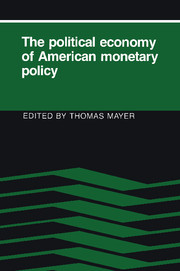Book contents
- Frontmatter
- Contents
- Preface
- List of contributors
- 1 Introduction
- 2 Studying the Fed: toward a broader public-choice perspective
- 3 The Federal Reserve reaction function: a specification search
- 4 Corporate profitability as a determinant of restrictive monetary policy: estimates for the postwar United States
- 5 Federal Reserve behavior since 1980: a financial-market perspective
- 6 The Federal Reserve and its institutional environment: a review
- 7 The political economy of monetary policy
- 8 Political monetary cycles
- 9 Congress and the Fed: why the dog does not bark in the night
- 10 The Federal Reserve as a political power
- 11 Monetary policy and political economy: the Federal Reserve and the Bank of Japan
- 12 A positive analysis of the policy-making process at the Federal Reserve
- 13 A theory of FOMC dissent voting with evidence from the time series
- 14 Explaining FOMC members' votes
- 15 Fed behavior and X-efficiency theory: toward a general framework
- 16 Minimizing regret: cognitive dissonance as an explanation of FOMC behavior
- 17 The discount window
- 18 Leaning against the wind: the behavior of the money stock in recession and recovery, 1953–8
- 19 Bureaucratic self-interest as an obstacle to monetary reform
- Index
13 - A theory of FOMC dissent voting with evidence from the time series
Published online by Cambridge University Press: 06 July 2010
- Frontmatter
- Contents
- Preface
- List of contributors
- 1 Introduction
- 2 Studying the Fed: toward a broader public-choice perspective
- 3 The Federal Reserve reaction function: a specification search
- 4 Corporate profitability as a determinant of restrictive monetary policy: estimates for the postwar United States
- 5 Federal Reserve behavior since 1980: a financial-market perspective
- 6 The Federal Reserve and its institutional environment: a review
- 7 The political economy of monetary policy
- 8 Political monetary cycles
- 9 Congress and the Fed: why the dog does not bark in the night
- 10 The Federal Reserve as a political power
- 11 Monetary policy and political economy: the Federal Reserve and the Bank of Japan
- 12 A positive analysis of the policy-making process at the Federal Reserve
- 13 A theory of FOMC dissent voting with evidence from the time series
- 14 Explaining FOMC members' votes
- 15 Fed behavior and X-efficiency theory: toward a general framework
- 16 Minimizing regret: cognitive dissonance as an explanation of FOMC behavior
- 17 The discount window
- 18 Leaning against the wind: the behavior of the money stock in recession and recovery, 1953–8
- 19 Bureaucratic self-interest as an obstacle to monetary reform
- Index
Summary
The main purpose of this chapter is to develop and test a theory that predicts the voting of individual Federal Open Market Committee (FOMC) members who dissent, on the side of either tightness or ease, from the Committee's regular monetary policy directives. It is initially assumed that such a directive reflects the monetary policy desired by a majority of the Committee and that the Committee controls monetary policy. It is further assumed that the central government, specifically the administration, has a strong influence on monetary policy (Havrilesky 1987, 1988) through ongoing communication with the Committee (or its chair) and through FOMC appointments (Havrilesky and Gildea 1989).
The theory predicts individual dissenting votes as a function of the difference between each of the dissenter's “characteristics” and the mean value for that characteristic for all FOMC members. Each characteristic is a measure of the member's “career proximity” to the central government. The desired monetary stabilization policy of the central government is assumed to have a time-consistent inflationary bias. Presidential appointments of 7 of the 12 members of the FOMC are assumed to reflect several objectives. These objectives include attaining politically optimal stabilization policy, paying political debts, building antiinflationary credibility, and satisfying the representational demands of constituents (Woolley 1984; Havrilesky and Gildea 1989). Because of these multiple objectives, the FOMC as a whole will have a lesser inflationary bias than will the central government. Therefore, members whose career-proximity characteristics are closer to the central government than are the FOMC means for those characteristics will tend to dissent on the side of ease.
- Type
- Chapter
- Information
- The Political Economy of American Monetary Policy , pp. 195 - 208Publisher: Cambridge University PressPrint publication year: 1990
- 29
- Cited by



